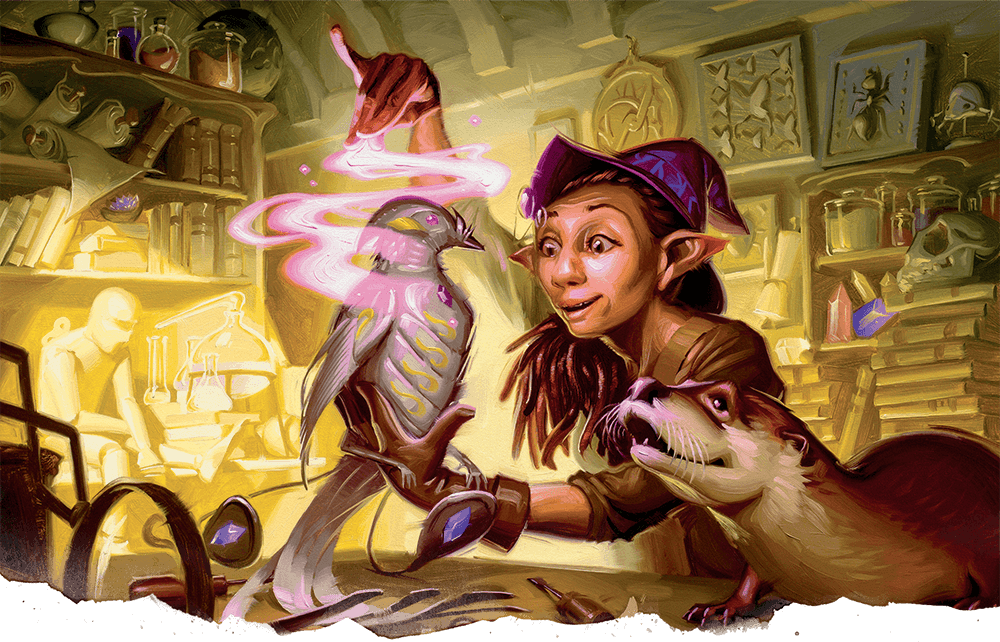Gnome
Ingenious and full of energy, gnomes are considered to be distant descendants of the fey. Slightly shorter than the halfling, and with long pointy ears similar to the elves, this small-framed race compensates for the lack of muscle with ever working brains and a great aptitude for invention. Even though their inventions have a bad habit of blowing up, no one can stay mad at a gnome. Their cheerful attitude, curiosity, and humor put the gnomes among the most likely to have a good feast or a carefree dance.
Apart from their joyful side, they have created some of the most impressive mechanical wonders of Toriel. Some gnomes, in the elemental plane of air, managed to build flying ship, when other back on the material planes, made the prototype of flintlocks. Those inventions are all reputed to be results of gnomish brilliance, but the secret of their invention is kept within the Lightfoot land. If you are looking for a gnome in a populated city, you just have to wait for the explosion to guide your steps.
Culture
A gnome is rarely bored and tries to savor every minute, for life is full of opportunities to learn, to help others, and to have fun. Gnomes are born with a fascination for learning fueled by an irrepressible curiosity. Most individuals settle on a specialized area of study such as an aspect of the natural world, a particular method of invention, or the patterns that underlie the multiverse. Though this pursuit of knowledge might compel a gnome to spend long periods in the workshop or the laboratory, the activity is never seen as drudgery — quite the opposite. Gnomes enjoy making an unexciting aspect of life more enjoyable, such as inventing a shovel that whistles a tune to lighten the toil of digging, or creating a telescoping fork that can reach across the table to enliven mealtime. Their fun-loving attitude also comes through in the form of jokes that gnomes tell to, or about, their companions, and in the good-spirited pranks that they play on each other — and on other folk (who might not always appreciate being the target of their humor). Gnomes aren’t overly goal-oriented as they pursue their interests. To them, the journey and the destination are one and the same, and an achievement at the end of one journey is merely the first step toward the next accomplishment. Even though failure, disappointment, and dead ends are recurring obstacles on the path to discovery, gnomes revel in the search. They savor the acquisition of new knowledge, realizing it might come at a cost, and even a series of bad results in experiments doesn’t dissuade a gnome from following their chosen path.Last rites
Gnomes have a tradition as the Last Ritual for the deceased among their kind. When a gnome passes away, their body is buried in a location of lush vegetation, such as a grove, a mushroom field underground, or an oasis in a desert. Before burial, a seed is placed in the gnome's mouth. As the seed grows, it gives rise to new vegetation, whether it be a tree, a bush, or a mushroom, depending on the environment. Gnomes believe that the growth of this vegetation facilitates the deceased's soul journey to the afterlife. It is considered a grave offense to neglect offering this final ritual to a deceased gnome.Characteristics
Physical features
A gnome’s energy and enthusiasm for living shines through every inch of his or her tiny body. Gnomes average slightly over 3 feet tall and weigh 40 to 45 pounds. Their tan or brown faces are usually adorned with broad smiles, and their bright eyes shine with excitement. Their fair hair has a tendency to stick out in every direction, as if expressing the gnome’s insatiable interest in everything around. Gnome are similar looking to halfling, if no for the added energy and the long pointy ears. A gnome’s personality is writ large in his or her appearance. A male gnome’s beard, in contrast to his wild hair, is kept carefully trimmed but often styled into curious forks or neat points. A gnome’s clothing, though usually made in modest earth tones, is elaborately decorated with embroidery, embossing, or gleaming jewels.Biology
Gnomes possess recessive genes, making half-gnome offspring impossible. When gnomes breed with other species, their children will always inherit the characteristics of the non-gnome parent.Mental traits
As far as gnomes are concerned, being alive is a wonderful thing, and they squeeze every ounce of enjoyment out of their three to five centuries of life. Humans might wonder about getting bored over the course of such a long life, and elves take plenty of time to savor the beauties of the world in their long years, but gnomes seem to worry that even with all that time, they can’t get in enough of the things they want to do and see. Gnomes speak as if they can’t get the thoughts out of their heads fast enough. Even as they offer ideas and opinions on a range of subjects, they still manage to listen carefully to others, adding the appropriate exclamations of surprise and appreciation along the way. Though gnomes love jokes of all kinds, particularly puns and pranks, they’re just as dedicated to the more serious tasks they undertake. Many gnomes are skilled engineers, alchemists, tinkers, and inventors. They’re willing to make mistakes and laugh at themselves in the process of perfecting what they do, taking bold (sometimes foolhardy) risks and dreaming large.Subraces
Rock Gnomes
A visitor’s first steps into a rock gnome warren are accompanied by the sounds of industry — hammers rapping on metal, chisels chewing wood, cauldrons bubbling, and a host of assorted squeaks, pings, and whistles. Against this backdrop, the halls echo with the voices of rock gnome inventors jabbering at near unintelligible speed about their latest ideas, and the hubbub is occasionally punctuated by a big bang or the abrupt collapse of some unstable contraption. To rock gnomes, life is a combination of scavenger hunts and periods of bold experimentation. First they get materials from within the earth (usually thanks to deep gnomes), and then they figure out what they can create or invent using those resources. The discovery of a new vein of metal — whether tin, copper, silver, or gold — makes rock gnomes clap their hands with glee, but they are happiest of all when they find a cache of gems, particularly diamonds. Individual rock gnomes have different ideas about what sorts of inventions are the most satisfying to create, with some favoring practicality and others more interested in artistic expression. In each group, there are those who prefer to practice the alchemical arts and those whose talents lean toward the creation of mechanical devices. Every warren has members of each persuasion, and they are all bound by mutual respect for what they do despite their different perspectives. Rock gnomes who take a more scientific approach to inventing are the ones responsible for creating technological devices that make life easier. Even an invention as simple as a new kind of rake is celebrated, and that advance might later be superseded by someone who modifies it in a way that makes it more efficient or more enjoyable to use. These inventors are rarely reluctant to try making devices of exceptional power, even if one might not work at first the way it was intended to. The gnomes know that it’s always possible for someone else to learn from an inventor’s mistakes, so even a failed experiment is a success in some way. Every minor explosion or other incident of turmoil in a gnome city serves as a clue about what not to do next time — unless, of course, the goal was to make something explode. Imagination runs wild in the mind of a gnome. Any fresh idea can be the starting point for a new journey of experimentation and discovery. Even though rock gnomes appreciate the practical aspects of their endeavors, they also find satisfaction in creating items that have no true usefulness. Many an invention is celebrated just for being beautiful to behold or for being complex and intricate in its construction, and the artists who create such things are as esteemed as those who specialize in designing tools. Exploration is a part of invention, as the gnomes see it, so there’s nothing wrong with creating machines and artifacts that seem to have no purpose. The gnomes who produce these works of art are using new ideas and new approaches, breaking through old boundaries and advancing the frontier of knowledge. For instance, an artist might create a beautiful articulated sculpture whose pieces can be manipulated in a unique way. Another artisan might take that idea and apply it to a new form of invention — but no one forgets that it was the artist’s idea that blazed the trail for that journey.Alchemists
Rock gnome alchemists explore the nature of minerals and chemicals, curious to see what happens when they mix certain substances with other compounds or with raw magic. Most alchemists, even those who busy themselves with experimentation and new ideas, can produce a number of useful substances, such as alchemist’s fire, antitoxin, super slippery goo, stone melting compound, stirge repellent, and glow-in-the-dark paint.Artificers
Rock gnome artificers construct exquisitely tooled and enameled pieces of machinery, often weaving magical properties into their work. Artificers often develop a reputation for a particular style and type of work. For example, a friendly gnome artificer might create lovable mechanical pets and companions, while a grumpy gnome might make snapping critter constructs with sharp teeth and claws. Gnome artificers can become famous, with their works highly sought after by nobles, wizards, and other collectors. An artificer’s inventions might include items such as a lock box that opens with a verbal command or a series of gestures, a clockwork critter designed to respond to simple commands, or a common magic item.Tinkerers
The creations of tinker gnomes range from the ridiculous to the dangerous. They love to push the art of invention beyond its limits, and to explore the instability of volatile materials. They cackle with glee after an ear-splitting bang, and jump and cavort amid lethal sprays of lightning. Though it might be bizarre and unusual, a working tinker gnome creation is a rare thing, and highly prized. Such inventions include the following:- A chain-driven tomato smasher that is also able to fly
- A lightning-powered portable rat-zapper — good for keeping out the vermin
- A floating metal facsimile of a beholder, complete with disintegrating eye rays
- A flock of exploding parrots





Comments